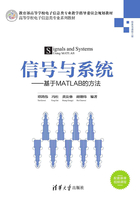
1.4 连续时间信号的分解
信号的分解特性是系统分析的理论基础。输入信号可以分解为众多基本信号的线性组合,因此只需要研究系统对基本信号的响应,就能方便地得到系统对任意信号的响应。信号可以从不同的角度分解,信号分解方式的不同导致系统不同的分析方法。下面讨论信号的时域分解。
1.4.1 信号的交直流分解
信号f(t)的直流分量是指信号的平均值,记为 ,它是信号波动的中心。信号随时间变化的部分称为信号的交流分量,记为
,它是信号波动的中心。信号随时间变化的部分称为信号的交流分量,记为 ,并且有
,并且有


若f(t)是功率信号,则有

式(1-36)说明,信号的平均功率等于其直流功率和交流功率之和。
1.4.2 信号的冲激函数分解

图1-23 信号的矩形脉冲逼近
任意信号可以用多个矩形脉冲来逼近,如图1-23所示。
当t=τ时,脉冲高度为f(τ),脉冲宽度为Δτ,存在区间为ε(t–τ)–ε(t–τ–Δτ),于是,此窄脉冲可表示为

当τ从–∞变化到∞时,f(t)可表示为多个窄脉冲的叠加

令Δτ→0,则有

当Δτ→dτ时, ,因此有
,因此有

式(1-38)表明,信号f(t)可以分解为不同时刻的、不同强度的冲激函数之和。在每个分解点τ处冲激的强度为f(τ)。
信号的冲激函数分解在系统分析中有重要意义。当求解信号f(t)通过LTI系统产生响应时,只需求解冲激信号通过该系统产生的响应,然后利用线性时不变系统的特性,进行叠加和延时即可求得信号f(t)产生的响应。
1.4.3 信号的阶跃函数分解
除了用多个矩形脉冲之和来表示信号之外,信号还可以用一系列阶跃信号的叠加来逼近,如图1-24所示。

图1-24 信号的阶跃信号逼近

当Δt→dτ时,kΔt→τ,∑→∫,因此有

当t从–∞变化到∞时,式(1-39)为

式(1-40)表明,信号f(t)可以分解为无穷多个阶跃信号的叠加。在每个分解点τ处阶跃信号的幅度为f′(τ)。
除了上述分解外,还有前面提到的信号的奇、偶分解以及虚、实分解等。信号的分解是系统分析的基础,不同的分解方法,导致系统不同的分析方法。在后面章节将会介绍信号的其他分解形式。